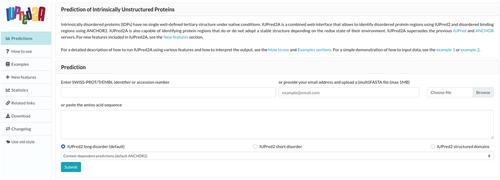Analyzing Protein Disorder with IUPred2A
Q1 Biochemistry, Genetics and Molecular Biology
Gábor Erdős, Zsuzsanna Dosztányi
下载PDF
{"title":"Analyzing Protein Disorder with IUPred2A","authors":"Gábor Erdős, Zsuzsanna Dosztányi","doi":"10.1002/cpbi.99","DOIUrl":null,"url":null,"abstract":"<p>IUPred2A is a combined prediction tool designed to discover intrinsically disordered or conditionally disordered proteins and protein regions. Intrinsically disordered regions exist without a well-defined three-dimensional structure in isolation but carry out important biological functions. Over the years, various prediction methods have been developed to characterize disordered regions. The existence of disordered segments can also be dependent on different factors such as binding partners or environmental traits like pH or redox potential, and recognizing such regions represents additional computational challenges. In this article, we present detailed instructions on how to use IUPred2A, one of the most widely used tools for the prediction of disordered regions/proteins or conditionally disordered segments, and provide examples of how the predictions can be interpreted in different contexts. © 2020 The Authors.</p><p><b>Basic Protocol 1</b>: Analyzing disorder propensity with IUPred2A online</p><p><b>Basic Protocol 2</b>: Analyzing disordered binding regions using ANCHOR2</p><p><b>Support Protocol 1</b>: Interpretation of the results</p><p><b>Basic Protocol 3</b>: Analyzing redox-sensitive disordered regions</p><p><b>Support Protocol 2</b>: Download options</p><p><b>Support Protocol 3</b>: REST API for programmatic purposes</p><p><b>Basic Protocol 4</b>: Using IUPred2A locally</p>","PeriodicalId":10958,"journal":{"name":"Current protocols in bioinformatics","volume":"70 1","pages":""},"PeriodicalIF":0.0000,"publicationDate":"2020-04-01","publicationTypes":"Journal Article","fieldsOfStudy":null,"isOpenAccess":false,"openAccessPdf":"https://sci-hub-pdf.com/10.1002/cpbi.99","citationCount":"201","resultStr":null,"platform":"Semanticscholar","paperid":null,"PeriodicalName":"Current protocols in bioinformatics","FirstCategoryId":"1085","ListUrlMain":"https://onlinelibrary.wiley.com/doi/10.1002/cpbi.99","RegionNum":0,"RegionCategory":null,"ArticlePicture":[],"TitleCN":null,"AbstractTextCN":null,"PMCID":null,"EPubDate":"","PubModel":"","JCR":"Q1","JCRName":"Biochemistry, Genetics and Molecular Biology","Score":null,"Total":0}
引用次数: 201
引用
批量引用
Abstract
IUPred2A is a combined prediction tool designed to discover intrinsically disordered or conditionally disordered proteins and protein regions. Intrinsically disordered regions exist without a well-defined three-dimensional structure in isolation but carry out important biological functions. Over the years, various prediction methods have been developed to characterize disordered regions. The existence of disordered segments can also be dependent on different factors such as binding partners or environmental traits like pH or redox potential, and recognizing such regions represents additional computational challenges. In this article, we present detailed instructions on how to use IUPred2A, one of the most widely used tools for the prediction of disordered regions/proteins or conditionally disordered segments, and provide examples of how the predictions can be interpreted in different contexts. © 2020 The Authors.
Basic Protocol 1 : Analyzing disorder propensity with IUPred2A online
Basic Protocol 2 : Analyzing disordered binding regions using ANCHOR2
Support Protocol 1 : Interpretation of the results
Basic Protocol 3 : Analyzing redox-sensitive disordered regions
Support Protocol 2 : Download options
Support Protocol 3 : REST API for programmatic purposes
Basic Protocol 4 : Using IUPred2A locally
用IUPred2A分析蛋白质紊乱
IUPred2A是一种组合预测工具,旨在发现内在无序或条件无序的蛋白质和蛋白质区域。本质上无序的区域是孤立存在的,没有明确的三维结构,但却具有重要的生物学功能。多年来,人们开发了各种预测方法来表征无序区域。无序片段的存在也可能取决于不同的因素,如结合伙伴或环境特征,如pH或氧化还原电位,识别这些区域代表了额外的计算挑战。在本文中,我们详细介绍了如何使用IUPred2A,这是预测无序区域/蛋白质或条条状无序片段的最广泛使用的工具之一,并提供了如何在不同背景下解释预测的示例。©2020作者。基本协议1:使用IUPred2A在线分析无序倾向基本协议2:使用anchor分析无序结合区域支持协议1:结果解释基本协议3:分析氧化还原敏感无序区域支持协议2:下载选项支持协议3:用于编程目的的REST API基本协议4:在本地使用IUPred2A
本文章由计算机程序翻译,如有差异,请以英文原文为准。
来源期刊
期刊介绍:
With Current Protocols in Bioinformatics, it"s easier than ever for the life scientist to become "fluent" in bioinformatics and master the exciting new frontiers opened up by DNA sequencing. Updated every three months in all formats, CPBI is constantly evolving to keep pace with the very latest discoveries and developments.


 求助内容:
求助内容: 应助结果提醒方式:
应助结果提醒方式:


